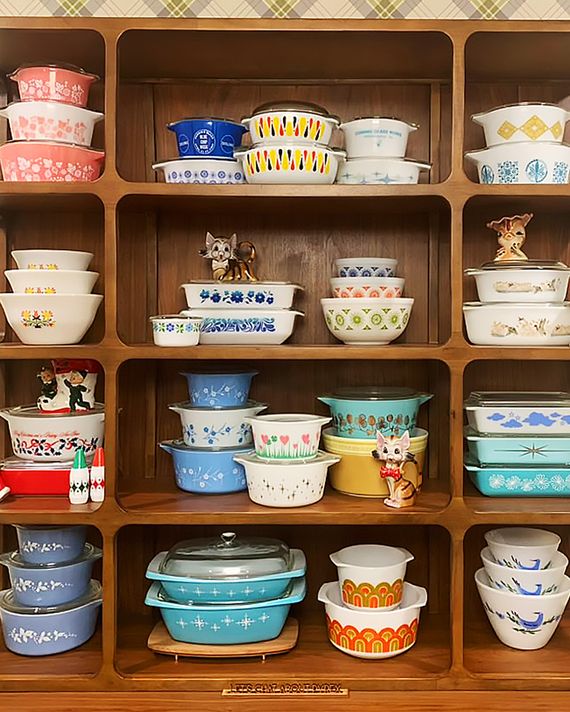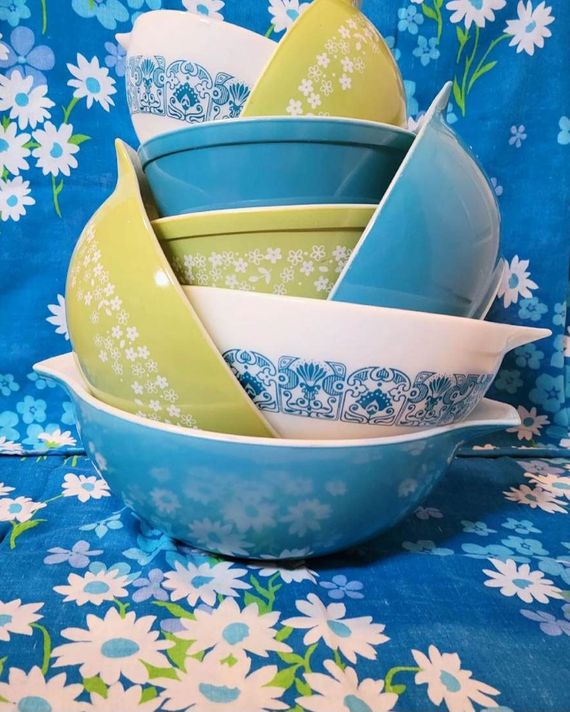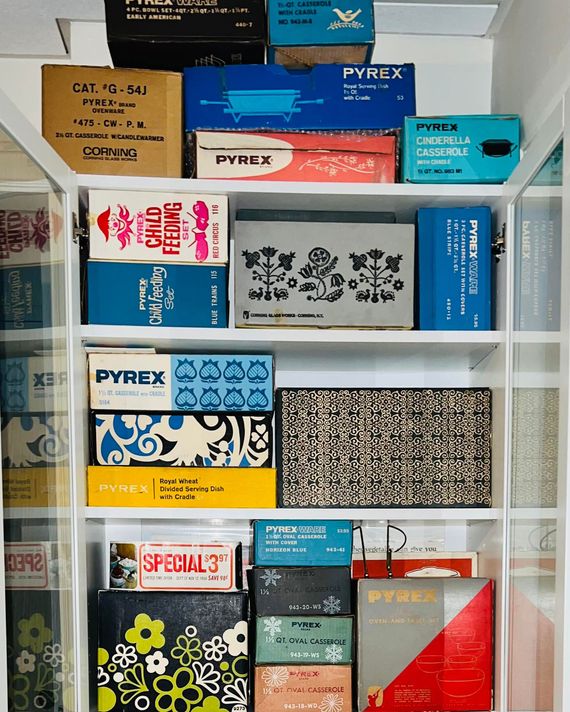
“Twenty thousand for a bowl?” That’s what most people said as the price of Lucky in Love continued ticking up on an eBay auction last year. No Pyrex is rarer than this bowl in the hearts-and-shamrocks print from 1959. Because it was a prototype or a limited edition from 1959, only a few pieces have survived, and even fewer find their way to the open market. Still, $22,100 — the winning bid — is a lot of money. (The previous record for a Pyrex dish in this pattern was around $6,000.) Thousands viewed posts about the auction on YouTube, TikTok, and Instagram until the final sum came in. “For heaven’s sake. Grandma’s around the world are rolling around in their graves!” wrote one viewer.
The auction brought a new wave of attention to die-hard Pyrex fans and their corners of the internet. In the “Let’s Chat About Pyrex” Facebook group, which has more than 500 members, and in groups like Pyrex Collectors and Pyrex and All Things Vintage, with more than 25,000 members each, members speculated about who the bidder might be. Was it the Corning Museum? Martha Stewart? The seller trying to artificially inflate the price? The forums are normally filled with friendly chatter about new acquisitions, holiday-themed displays, and rare patterns spotted in an antiques mall or on Facebook marketplace. But rising prices and increasing competition have brought some tension into a scene that many consider a community. Just a few days ago, another piece of rare Pyrex — a pink bowl in the Duchess pattern, with its original lid and brass warming stand included — sold on eBay for more than $4,000.
The craze for vintage Pyrex isn’t new, but it is growing. Corning, which bought Pyrex in 1936, stopped producing the opalware line in the late 1990s, and the rights to the name are now held by a private-equity firm. (The clear borosilicate glass products, also known as Pyrex, are still in production). Decades later, thanks to their durability, many vintage Pyrex pieces are still in good condition with more than 150 patterns to collect. Produced mostly between the 1940s and the early 1980s, they cover virtually every trend from the second half of the 20th century, from Americana-inspired pieces with bald eagles to atomic-age starbursts and line-drawn daisies popular in the 1980s.
A big part of the appeal is how easy it is to begin, often with what’s already in the cupboards. People tend to think of Pyrex patterns as “their own,” and common patterns are still reasonably priced. Those who grew up eating on white-on-pink Gooseberry, for instance, are able to buy most pieces in that style for less than $100, while others may have memories of family meals in Blue Tulip casserole dishes, which can be picked up on Etsy for as little as $35.
Dawn Bornheim Thompson, an Oregon-based collector, began collecting Pyrex more than a decade ago when she tried to re-create a set her family had used in the 1960s. Once she completed it, she thought she was done. But then she went into an antique shop, where “on the floor, covered in layers and layers of dirt, was this gorgeous yellow-and-gold piece. And I’m like, ‘Oh God, there’s more.’ And I never looked back after that.” Since then, Thompson has amassed hundreds of Pyrex pieces, which she regularly posts on Instagram to nearly 20,000 followers.
For resellers of Pyrex, life has gotten pretty hectic.
“Hi, cute friends!”
This is how Nate Smith kicks off his Instagram Live sessions as @myvintageis1976. On each edition of Let’s Chat About Pyrex, the weekly show he hosts, the 47-year-old Smith, sporting a bow tie, kicks off a conversation about hunting for Pyrex, styling Pyrex, and selling Pyrex. Smith, who works full time as a high-school teacher, is an upbeat narrator for the hundreds who regularly join in, and along with discussions of Easter displays and Pyrex from around the world, he sometimes hosts sales, offering pieces he finds on his trips around the country — some of which he takes just to shop for Pyrex. He films most of his live shows in his kitchen, where the backdrop shows shelves stacked with his rotating collection.
Smith got into Pyrex the way a lot of people do — digging through piles of it in his childhood home. In the process of helping his sister clean out their parents’ house, he discovered what they had collected at Goodwill over the years. “Before I knew it, I was bringing home a Subaru loaded down with Pyrex. And then I would dig through another layer and there would be more.” When he learned about the market for vintage pieces, he started his own collection, which is now well into the hundreds. As for selling it, he says it’s less a moneymaking venture than a way to make sure his collection doesn’t take over his house. When he does host a sale on his Instagram show, pieces usually sell out as soon as he lists them.
If there is a public representative for Pyrex fans, Smith is definitely one of them, considered both an expert and a friend to all Pyrex lovers. Still, many collectors were surprised (and delighted) to see the Lucky in Love bowl that sold for $22,000 make its debut on Smith’s Instagram account. It turned out that the auction winner had backed out of actually paying the final price, and the seller had offered it at a private sale to a handful of bidders, which Smith won (he declined to share exactly how much he paid, but confirmed it was much less than $20,000). For him, acquiring Lucky in Love was partly a sentimental move — the pattern was the perfect motif to represent his marriage to his Irish husband. It’s one of the pieces in his collection he’ll never part with, he said.
While collectors are split on whether or not to use their pieces, some do. Wilson Southerland, who lives not far from the home of Corning in upstate New York, sometimes uses part of his collection in his Instagram Live cooking show. He started collecting a few years ago after viewers commented on a bowl that appeared in one of his videos. Southerland, a music professor, started to research Pyrex patterns and found himself exhaustively studying every pattern that had ever been made “all day, every day for probably six weeks” with a set of flashcards he’d made himself. He decided to focus his search on rarer patterns, like Bar Code and Fleur de Lis, and also on pieces that come with their original boxes. Southerland’s kitchen cabinets now double as Pyrex shelves, while a cabinet in his apartment holds an assortment of pieces in their original boxes. It has yet to take over his home.
As new fans join the hunt, Pyrex communities across the internet are increasingly forced to reckon with what it means to get a good deal — and what it means to play fair. Recently, a rare piece, pink with a gold tulip-inspired pattern, was posted on Mercari for $400 — a good deal. A newer collector bought it, but before it shipped, the seller became aware of its value. He canceled her order and relisted the bowl for several thousand dollars. “Should he have done his research before he listed it on Mercari for a Buy It Now? Yes, he should have,” Smith said.
Still, how do longtime collectors feel about prices jumping up into four- and five-figure amounts? “I will say if these prices were associated with classic cars, if these pieces were associated with coins,” Smith said, no one would really care. “Yet it seems like in the Pyrex community, we get questioned a lot on the amount of money that we have paid.” Both Southerland and Thompson, the collector in Oregon, also pointed out that what they’ve spent on Pyrex is in line with or even less than what collectors of rare coins or baseball cards might spend.
Collectors of rare Pyrex also hunt for misprints, pieces produced for a specific restaurant, and samples that never went into production. But ultimately, value is in the eye of the beholder. “There is the camp of people that won’t pay more than 20 bucks for a piece,” says Southerland. When I asked the members of several Pyrex Facebook groups what their most coveted Pyrex was, I rarely saw the same answer twice. Some collectors wanted a Lucky in Love of their own, while others were on the hunt for anything in good condition. Others are committed to seeing whatever turns up at their local thrift stores.
While there are still deals to be had — and, as several people pointed out, more product hitting the market every year — even thrift stores are getting in on the bidding wars. In 2017, a Pyrex-savvy staffer at Goodwill of Western New York spotted a Lucky in Love bowl in a donation box and quickly alerted her manager. The piece became one of a number of Pyrex dishes to be sold on Goodwill’s official auction site, with the winning bid coming in at almost $6,000. Now rare Pyrex is a regular feature on the site, with some collectors thrilled about the chance to score pieces from across the country and others missing the days when brightly colored Pyrex bowls could be nabbed in-store for a few bucks.
Not every nostalgic kitchen brand is as coveted as Pyrex. Tupperware, a staple of mid-century kitchens, was once the ubiquitous direct-to-consumer choice, stacked next to Pyrex in the cabinets. It’s easy to imagine, decades ago, cooking up a casserole in a Butterprint dish and then transferring the leftovers into a sturdy Tupperware container purchased at a home-based selling party. But the company has expressed “substantial doubt” about the future of its business, suggesting the brand no longer connects with younger consumers. The 80-year-old company’s food storage options have become indistinguishable from many of its competitors, which are often much cheaper.
And yet Pyrex endures, on tables, in cabinets, and online. The colorful dishware has spawned its own vocabulary, with collectors throwing around terms like “Big Bertha” (an especially large casserole dish) and “Cinderella” (a bowl with a spout, making it easier to pour batter into a pan). Like any fandom, it has a trove of merch. Scrolling Etsy, one can find Pyrex shirts, Pyrex bowl earrings, and even Pyrex-themed pajamas. There are also more than a few listings for Pyrex decals — sticky replicas of the brand’s famous prints, including Lucky in Love itself, which can be attached to bowls to imitate the impossible-to-find pattern. (The downside of this is that the Pyrex Facebook groups are also filled with members asking if their finds are too good to be true.)
Some newer brands are hoping to capture some of the enthusiasm for Pyrex with their own homeware designs. Great Jones is one of them. The brand’s ceramic pieces, in shades of vivid cobalt blue and bubblegum pink, are intended to be a kind of homage to Pyrex, as cookware that can go straight from the oven to the table. Sierra Tishgart, founder of the company, hopes to go further in that direction. Currently, the brand’s casserole dish, Hot Dish, is emblazoned with a wavy white print that has a ’70s Pyrex vibe. “My personal dream is that I wander into a vintage store 50 years from now and I see one of our pieces and it’s held up,” she says. “No one does that better, in my opinion, than Pyrex.”
The next generation of Pyrex collectors is just as enthusiastic. Riley Lesser, an 18-year-old from North Carolina, got hooked while accompanying his mom to yard sales and thrift stores. The art student’s love of color and patterns made him a natural at spotting fun Pyrex pieces, and now, as he looks for bowls and bakeware to furnish his first grown-up apartment, he says, “I will be collecting Pyrex for the rest of my life!”







